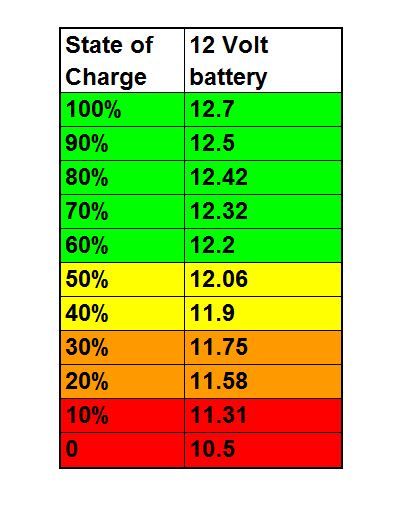Unless you are going to revert to lanterns and candles, you not only will need sources of electric power but if you plan to do any off-grid camping you will need to know more than how to plug your camper into the pedestal provided in a full hookups site.
Our T@B 400 has the capability of running either off a 120V source (a shore power line or a generator) or a 12V battery system. In either case it’s wise to understand how much power is available to you and how much the appliances you want to use will require.
______________________________________________________________________________
Battery Basics

One of the realities of RV ownership is that you will make a few mistakes along the way and for many of us one of the first mistakes is to allow the battery to totally discharge. Our experience with car batteries doesn’t actually prepare us to deal with RV batteries. The two of us vividly remember the day in 2013 when we discovered we’d exhausted the battery in our brand new T@B-CS. That’s when we realized we needed to learn more.
The biggest lesson we learned early was the need to pay attention to the battery’s state of charge. Start with a simple battery monitor, available from Amazon, Walmart and other retailers that plugs into a 12V socket in your trailer. Notice on the chart above that 12.7V or more is full charge. For wet cell batteries always keep the state of charge greater than 50% or more than 12.06V. Your most accurate reading will be with the trailer unhitched and not connected to a source of power. Also know that if you’ve just disconnected from power (shore, generator, solar, tow vehicle) that your battery may have a surface charge that will give a temporarily higher reading that actual state of charge. Either let the battery rest for a couple of hours or run the fridge off of battery for a few minutes.
Most camping trailers including T@Bs and T@Gs are equipped by the dealer with wet cell batteries. In addition to needing to monitor voltage closely to avoid damage, wet cell batteries need to have distilled water added to the cells on a regular basis. Here’s a link on the how and why of watering your battery. It’s important to get distilled water for the task, tap or spring water can damage the battery. Distilled water is available in the grocery store in gallon bottles but can be found in pharmacies for use in CPAP machines in smaller, more convenient sizes.
T@B 400s come equipped with AGM batteries. Both wet cell and AGMs are lead acid technology but the AGM’s are sealed and have the advantage of having an 80% depth of discharge capability meaning you can dip down to 11.58V on occasion without damage to the battery. That said, we still like to keep our depth of discharge to 50% on our AGMs. For a more in-depth look at AGM depth of discharge here’s a link to a discussion on the T@B Forum.
To get you started, Jenn Grover gives an excellent overview of the care and feeding of her T@B wet cell battery: Part One and Part Two.
This is an excellent introductory article about the difference between battery types and RV battery care. If you want to know more, Battery University is a wealth of information.
In 2021 we upgraded to two 100Ah Battle Born Lithium Iron Phosphate Batteries in our T@B 400. This gives us 200 amp hours of usable power since LiFeP04 batteries can be fully discharged. That said, we still keep an eye on the percent of discharge shown on our Victron Monitor and make solid plans to recharge before we get to 20% or less state of charge. Of note, when we’re connected to 30A shore power for recharge the converter draws at least 25A as it begins to recharge the battery. We take that into consideration before starting up the air-conditioner, the Alde system, or any high amp draw appliances.
______________________________________________________________________________
Solar Panels
We love to camp off-grid also referred to as dry camping or boondocking. It’s self contained camping requiring no electric, water, or sewer hookups. This gives us the ability to camp in national park and national forest campgrounds, do dispersed camping on BLM lands, stay at Harvest Hosts sites, and in a pinch accept the hospitality of Walmart, Cracker Barrel, or a number of businesses that welcome RV overnight stays.
Off grid camping helps keep our trip lodging costs down and it also gives us the opportunity to camp near beautiful places that we want to explore. It also makes it exceedingly important to understand your power needs and your battery’s capacity. It ruins the experience if you are sweating over whether the battery will be drained and therefore damaged by morning. Two ways of keeping your battery charged are solar panels or a generator. Using solar alone you can operate all your 12V equipment lights, vent fan, 12V television, 12V sound system, and anything you can plug into one of the USB or 12V (cigarette lighter style) ports.
In June 2020 we traveled to the nüCamp RV Repair Shop to have them install a Sunflare 192W rooftop solar panel. We’re impressed with the CIGS technology both in terms of it’s efficiency and it’s carbon footprint. Back at home our T@B is currently parked in the driveway and gets only a few hours of sun each day but nonetheless it keeps the battery fully charged even when we have the Norcold 12V compressor refrigerator running.
If we’re also plugging the coffeemaker into the inverter for our first cup of coffee or if we’re experiencing a cloudy day, we set up our 160W of Zamp suitcase style panels. In our case it’s two 80W panels for two reasons. The first is that we’ve had one of them since 2013 and it was just easier to add the second when we wanted to upgrade in 2017. But more importantly the 160W panels are much heavier and bulkier thus harder to handle and harder to store.
We have two Victron 100/20 smart charge controllers mounted under the bed and wired in parallel to the battery to separately control the rooftop and the portable units. This means that if for instance the rooftop panel is in the shade and the portable panels are in the sun, the lower collection rate of the rooftop unit will not affect the better collection rate of the panels in the sun. We also installed a smart Victron Battery Monitor nearby to monitor our amp hour usage and battery level. Regarding our Zamp panels, we removed their original PWM controllers in favor of the more efficient MPPT technology utilized by Victron. That also gives us the convenience of using the Victron phone app. Although we could wire the two panels in series to get a 24V array, less resistance across the wire, and better efficiency, we opted to just use the Zamp Y-Connector to connect both panels in parallel to the Zamp Port that we had installed by the nüCamp RV Repair Shop.
Admittedly Zamp panels are more expensive than most but we are fans of their efficiency and durability as well as the fact that the panels themselves come with a 25 year warranty and that they are made in America, in Bend, Oregon. In fact in 2018 we had the opportunity to tour the factory and were very impressed.
In 2021-22 we upgraded again, this time we have two Sunflare 192W panels on rooftop and replaced our Zamp panels with the Bluetti PV200 Solar Panel. Our decision was based on the lighter weight and smaller footprint of the Bluetti panel compared with the Zamp panels, but we’ve been most impressed with it’s efficiency. We can routinely get at least 150W of solar generation when in direct sunlight, giving a significant boost to our rooftop array, a distinct advantage when we’re in full shade or on a rainy day. One disadvantage of the Bluetti and of any panels designed to pair with a portable power station is that they are not plug and play with the stock solar port on T@B trailers. We installed a second Victron controller inside our T@B when we removed the older PWM controllers from our Zamp panels. Another consideration was the need for an adapter between the Bluetti and the Zamp port on our T@B since the Zamp polarity is reversed from most if not all other solar panel designs.
Here’s a nice overview of Monocrystalline, Polycrystalline, and Thin Film Solar Panels that’s focused primarily in home installations with just a nod to the use of flexible panels for RV installation.
______________________________________________________________________________
Generators
A good second backup is a generator. A generator can serve the purpose of powering your camper with 110V household current and making your standard electric plugs operational. For years we traveled with a Honda EU2000i generator which was superseded in 2018 by the Honda EU2200 the extra 10% output allows many T@B owners to run their air-conditioners. Quality is one reason we choose a Honda generator, another reason is how quiet a Honda is. Less expensive generators could make you very unpopular in the campsite.
In 2022 we made the decision to abandon the gas generator as a back-up. We had never even attempted to use ours for air conditioning and balked at the weight and footprint of our Honda. Instead we opted for a Bluetti EB70S Portable Power Station. We chose Bluetti from among the several portable power stations/solar generators on the market because of the safety, stability, and durability of the lithium iron phosphate chemistry. Essentially it’s an auxiliary 60 amp hour battery with built-in inverter and solar controller. On the road we use it to power a portable compressor driven fridge in the back seat of our truck or to charge our electronic devices when we’re in an off-grid situation. A bonus is that when we’re at home it can power our household refrigerator and recharge off of solar during a power outage!
______________________________________________________________________________

